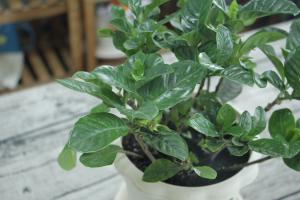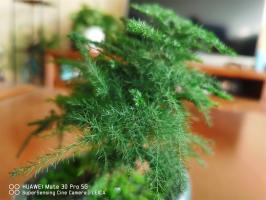Crab claw orchid sprinkles some towel gourd collaterals, not rotten roots and bright leaves
Towel gourd is usually used for washing dishes, which is environmentally friendly and easy to use. Loofah has a loose and porous structure, which can also be used to sprinkle the bottom of the basin

Usage:
1. After drying the loofah collaterals, cut the loofah collaterals into small pieces according to the size of the flowerpot
2. When changing the pot, pad the loofah at the bottom of the pot, fill it with flower soil and plant flowers
3. After the towel gourd is padded, the drainage in the flowerpot is very good. Flowers with weak roots such as crab claw will not rot their roots. Moreover, after loofah rots in the soil, it will be transformed into fertilizer, killing two birds with one stone
The rich tree sprinkles some pine pagodas, the branches are luxuriant and the leaves are not yellow
Pine pagoda is common in the mountains, with many gaps in its shape. It is also a good material for the bottom of the basin

Usage:
1. The pine pagoda collected from the mountain is likely to have fungi. It is best to bubble it with potassium permanganate solution for disinfection and reuse
2. After the pine tower is disinfected and dried, it can be spread on the bottom of the basin. Because of its large size, the pine tower is more suitable to be placed in a deep flowerpot, such as fortune tree, money tree and so on
3. Fortune tree, happiness tree and other "big men" are most afraid of stagnant water and rotten roots. After a layer of pine tower, this problem will not occur, and the leaves are healthy and green
Clivia sprinkles peanut shells, with strong roots and bright leaves
Flower friends who usually like to eat nuts can also collect some peanut shells and walnut shells and sprinkle them in the basin

Usage:
1. Peanut shell and walnut shell can only be used with original flavor, otherwise the shell will contain salt, which is bad for flowers. When you use it, just sprinkle it directly on the bottom of the basin
2. After the peanut shell is padded, the flower soil is not only more breathable, but also a good flower fertilizer. After being absorbed by Clivia, the leaves are thick and green
More meat, sprinkle some ceramsite, fat, not rotten roots
Succulent flowerpots are generally small, so choose something small and sprinkle it on the bottom of the basin. Ceramsite is very suitable for succulent plants

Usage:
1. First, cover the drainage hole with a layer of gauze to prevent soil loss. Then lay a layer of ceramsite
2. After paving the ceramsite, fill in the prepared soil, gently compact it with a shovel, and finally plant more meat
3. After being padded with ceramsite, the drainage of the soil is improved a lot, the meat afraid of waterlogging will not die of waterlogging, and the probability of black rot is greatly reduced
Chinese roses sprinkle pine needles, and new buds sprout
We all know that pine needle soil is very fertile and is a natural nutrient soil. In fact, pine needles can also be directly sprinkled on the bottom of the basin, with excellent ventilation effect

Usage:
1. Dig some pine needles from under the pine tree. Choose the darker pine needles at the bottom. These pine needles are basically rotten and are best used to raise flowers
2. After taking the pine needles home, scald them with boiling water first, and then dry them in the sun. Lay 2 ~ 3cm thick in the flowerpot, and then fill it with flower soil
3. After being padded with pine needles, the flowerpot of rose has good drainage and absorbs the nutrition of pine needles. When it comes to the growing season, new buds rub and sprout constantly
The camellia sprinkles some sawdust and has many green leaves
Whether it's the wood chips left over from decoration or the shavings bought by raising hamsters, they can be used to sprinkle the basin bottom to make the basin soil loose and breathable

Usage:
1. The amount of wood chips on the bottom of the basin is relatively small, so you can directly lay a layer. But if you want to use it in large quantities, you'd better rot it first and then use it again
2. For camellia, which likes humidity and is afraid of waterlogging, scattering sawdust in the basin can make the excess water in the basin discharge faster. In this way, you don't have to be afraid that more watering will lead to the rotten roots of Camellia
Orchids sprinkle pine bark, strong roots and strong leaves
The biggest fear of raising orchids is rotten roots. If the roots are rotten, the whole pot of orchids will be finished. If you sprinkle some pine bark on the bottom of the basin, you can prevent this problem

Usage:
1. The pine bark on the mountain may contain fungi and insect eggs, which should be disinfected before use. Find an old pot that is not used, pour in the pine bark, add water and bring to a boil
2. After drying the pine bark thoroughly, sprinkle a few pieces at the bottom of the flowerpot. Don't sprinkle too much. Then add other plant materials and plant orchids
3. If you sprinkle pine bark on the bottom of the basin, the orchid is not easy to rot. in the process of slow ripening of pine bark, it also provides a lot of nutrition for the orchid, making the orchid leaves more robust and stylish
When it comes to the skills of raising flowers today
As long as you learn, flowers will not rot again
If you feel practical, share it with more flower friends

 how many times do yo...
how many times do yo... how many planted tre...
how many planted tre... how many pine trees ...
how many pine trees ... how many pecan trees...
how many pecan trees... how many plants comp...
how many plants comp... how many plants can ...
how many plants can ... how many plants and ...
how many plants and ... how many pepper plan...
how many pepper plan...































